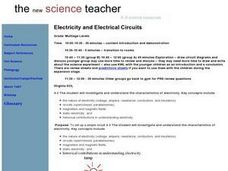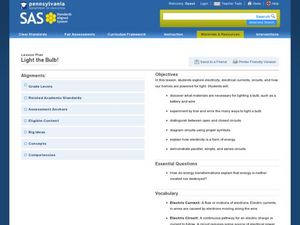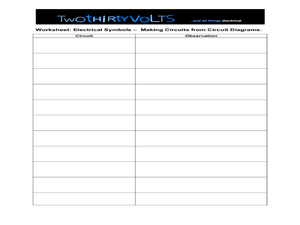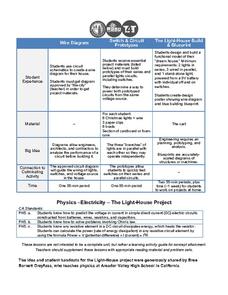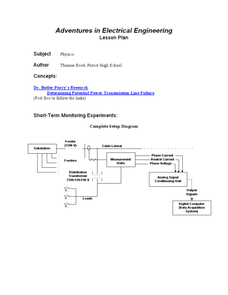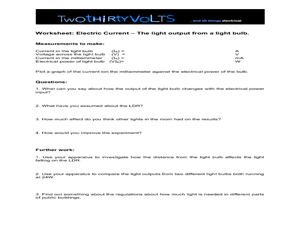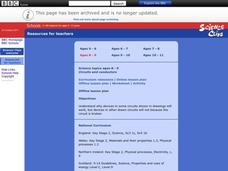Curated OER
Electricity and Electrical Circuits
Learners are introduced to electricity and electrical circuits. In groups, they draw circuit diagrams, complete a KWL chart and discover the difference between open, closed and series circuits. They define new vocabulary and make...
Curated OER
Investigating Electrical Circuits
Sixth graders draw and construct a complete circuit. In small groups they develop a list of questions about electricity, listen to a teacher-led lecture, construct a complete circuit, test circuits, and create an illustration of a...
Institute of Electrical and Electronics Engineers
Get Connected with Ohm's Law
Ideal for your electricity unit, especially with middle schoolers, this lesson plan gets engineers using multimeters in electrical circuits to explore the relationships among voltage, current, and resistance. Older learners may even plot...
Bonneville
A Simple Circuit
Heat up a lesson on solar energy by building a circuit for a cooling fan. Given a solar module and a DC motor, scholars develop hypotheses for how to make the fan turn. They test out their hypotheses, and then draw a circuit diagram to...
Curated OER
Solar Kit Lesson #3 Parts of a Solar Panel - Part I
A solar cell is similar to a rechargeable battery in many ways. Science lab groups connect each in a series circuit to run a mini motor and then compare and contrast them by answering questions and completing a Venn diagram. This is an...
Pennsylvania Department of Education
Light the Bulb!
Third graders investigate electrical circuits and how light bulbs are powered. In this electricity and power lesson, 3rd graders study the vocabulary necessary which includes the different types of circuits, electrical currents, and...
Curated OER
Solar Kit Lesson #1 - Solar Cell Inquiry
Give youngsters the components of a solar-powered electric circuit and turn them loose to figure out how to connect them in order for a light to shine or motor to turn. They compare energy output of a solar panel to that of a battery. On...
Curated OER
Physics: Electricity and Magnetism
Learners draw series and parallel electrical circuits. In this electromagnet lesson, students describe how current changes depend on circuit components. Learners use an OHT of a series and parallel circuit to predict the path...
Curated OER
Electrical Symbols - Making Circuits from Circuit Diagrams
Students draw different electrical circuit symbols. In this electricity lesson, students construct simple circuits based on circuit diagrams. They share their findings to class.
Trash For Teaching
The Light-House Project
Groups work together to design a lighthouse, from designing and drawing the wiring diagram, to creating prototypes of the switch and circuit, to envisioning and building a scale model along with a blueprint. By including different...
Curated OER
Adventures in Electrical Engineering
Learners explore electricity by conducting a series of experiments. For this physics lesson, students discover the relationship between current, voltage and resistance. They calculate voltage and power in a given system.
Curated OER
Electric Current: The Light Output from a Light Bulb
Young scholars investigate the energy used by a light bulb. In this electrical energy lesson, students conduct an investigation to explain the relationship between the output of light and the electrical power used by a light bulb.
Curated OER
Electric Circuits
Students model the flow of electrons in a circuit, draw diagrams of an electric circuit and build an electric circuit. Students explain how to tell when the path of an electric circuit is complete, and test the conductivity of a variety...
Curated OER
Changing circuits
Students identify that there are conventional symbols to represent the components in circuits. Students use these symbols to draw diagrams of circuits. They are reminded that electric circuits can be drawn in diagrams using symbols. ...
Institute of Electrical and Electronics Engineers
Insulators and Conductors
In a classic activity, emerging electricians test various objects for electrical conductivity in a circuit. Each group constructs a simple circuit by following a diagram. Predictions are made and objects are inserted into the circuit,...
Curated OER
Bulbs & Batteries in a Row
Students investigate simple series circuits and their properties. In small groups they draw a circuit diagram on their Series Circuit Building worksheet, follow step-by-step directions to construct a simple series circuit, and solve...
Curated OER
Circuits
Fifth graders discover the differences between parallel and series circuits. They draw and construct the two types of circuits using wires, bulbs, batteries, sockets, and switches.
Curated OER
Circuit Breakers
Fifth graders build a circuit breaker and examine its function within a circuit.
Curated OER
Electrical Circuits - Current & Voltage in Series Circuits
Pupils investigate the relationship between current and voltage in a series circuit. In this physics lesson, students measure the current across each light bulb. They predict what happens to the circuit if one bulb is blows out.
Curated OER
Basic Electric Circuits
Students calculate the resistance across a bank of resistors in a series, parallel and combined circuit. Using new vocabulary words, they define and describe them in a scientific manner. After stating Ohm's Law, they solve electrical...
Curated OER
Electrical Circuits And Switches
Learners design and draw circuits with batteries, small light bulbs and common household conductors. They build and test the circuit then modify it so someone who couldn't use their hands could turn the circuit on and off.
Curated OER
Circuits
Students draw a schematic diagram of parts needed to build an op-amp. For this physics lesson, students test the operation of their machine. They graph and analyze data using excel.
Curated OER
Electrifying the World
Students explore the fundamental concepts of electricity. They examine different circuit diagrams to study how electricity flows. They finish by creating their own simple circuit.
Curated OER
Circuits And Conductors
Students predict the common classroom items, such as paper clips, chalk, keys, or erasers, that will be good conductors in a circuit. They build circuits using a variety of circuit diagrams to test their predictions.
